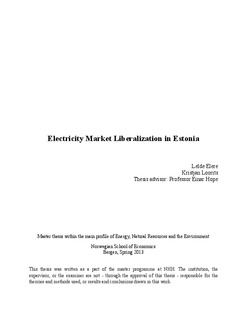| dc.description.abstract | The aim of the master thesis is to describe and analyze the deregulation process of the Estonian electricity sector. The analysis is based on a textbook model, which summarizes attributes that have led to successful electricity sector deregulation in other countries. According to the analysis, Estonia has followed the textbook model rather closely – it has separated competitive segments from natural monopolies, established a single system operator, created a wholesale spot market, unbundled electricity tariffs and created independent regulatory agencies. We conclude that the deregulation process has been successful. However, we identify the concentration of the generation market as a threat to an efficient market. The future challenge of Estonia is integration in the common European electricity market which is dependent on building sufficient transmission capacities and Europe-wide harmonization of regulations. Integration in the European Internal Electricity Market will contribute to improved effectiveness of the market, security of supply and increased long-term social welfare. | no_NO |
